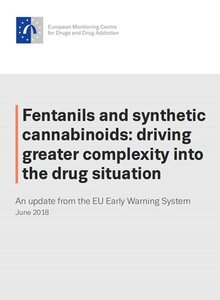Fentanils and synthetic cannabinoids: driving greater complexity into the drug situation
European Monitoring Centre for Drugs and Drug Addiction (EMCDDA) (2018)
An update from the EU Early Warning System
New psychoactive substances are a broad range of drugs that are not controlled by the 1961 and 1971 United Nations drug control conventions but may pose similar threats to public health. Many of them are traded as ‘legal’ replacements to established controlled drugs such as cannabis, heroin, cocaine and MDMA.
Over the last decade, there has been a large increase in these substances as globalisation and new technology have allowed production to shift from small-scale illicit laboratories in Europe to commercial chemical and pharmaceutical operations in China that are capable of making hundreds of different substances on an industrial scale. Once in Europe, they are sold openly in branded products advertised as ‘legal highs’, under the guise of being ‘research chemicals’, and as ‘food supplements’, in attempts to make these substances attractive to users. They are also sold on the illicit drug market, either under their own names or passed off as established controlled drugs to unsuspecting users. In parallel with the growth in the range of substances and products that are offered, the consumer base has also grown and includes recreational users, chronic and marginalised drug users, those who self-medicate, and people wanting to improve how they look or their performance at work or when studying. The growth in the market is also reflected in a large increase in the number of seizures reported by law enforcement as well as in poisonings.

Fentanils and synthetic cannabinoids: driving greater complexity into the drug situation



